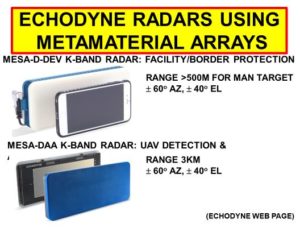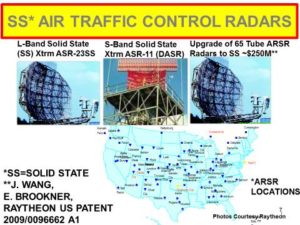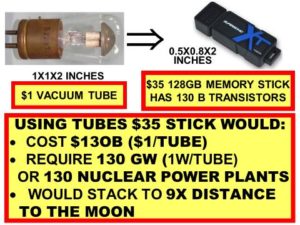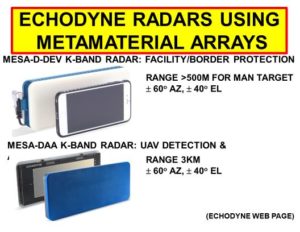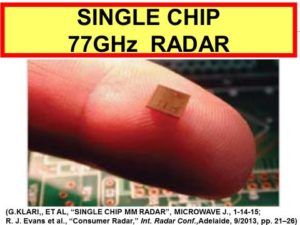Radar Basics and Recent Amazing Advances – Fall 2017
Dates: Mondays, November 6, 13, 20, December 4, January 8, 22, 29 & February 5 (if needed snow/makeup days February 12, 26)
Time: 6:00PM – 9:00PM
Decision date: Friday, October 27, 2017
Early Registration Date deadline: Tuesday, October 24, 2017
Before Early Registration Date
IEEE Members: $300
Non-members: $340
After Early Registration Date
IEEE Members: $340
Non-members: $370
WHERE: MITRE Corporation, 202 Burlington Road, Bedford, MA – Building M.
Phone 781-245-5405
email sec.boston@ieee.org
Fax 781-245-5406
If paying by check, the check must be received before the appropriate dates for Early Registration and Decision Dates.
Make Checks payable and send to:
IEEE Boston Section
One Centre Street, Suite 203
Wakefield, MA 01880
The following book plus over 15 paper reprints are provided FREE with your registration:
1. “Aspects of Modern Radar”, Dr. Eli Brookner (Editor), Artech House, Hardcover, 432 pages, 1988, List price: $159. The 1st chapter gives the best easy to read introduction to radar. It covers all aspects of radar: transmitters, receiver, antennas, signal processing, tracking, clutter derivation of radar equation in easy terms and definition of dB. The 2nd chapter gives detailed descriptions of different radar systems like: Cobra Dane, Pave Paws, BMEWS, Series 320 3D radar, OTH radars and dome antenna. The book has a catalog giving the detailed parameters for over 200 radars from around the world. The remaining chapters cover AEGIS SPY-1, Hybrid and MMIC circuits, ultra low sidelobe antennas (ULSA), mmw, radar cross section and Doppler weather radars. The material in the book is easy to access and as a result the text serves as a handy reference book.
All Attendees of the class will receive a trial license of MATLAB, Phased Array System Toolbox, and Antenna Toolbox from MathWorks in addition to a set of examples which help demonstrate the key radar concepts covered in the course material. MathWorks will also give a radar demonstration.
This course is an updated version of the Radar Technology course given previously. Those who have taken the Radar Technology previously should find it worthwhile taking this revised version. New material includes latest on solid state devices and transmitters including GaN, SiC, SiGe; Breakthroughs in Radar — $10 T/R module, Digital Beam Forming (DBF), Packaging, Disruptive Technology, Metamaterials, radar on a chip, 256 element phased array on a chip, Memristors, Graphene. Also covered are radar height-range coverage diagram using the powerful SPAWAR’s AREPS program. AREPS provides coverage for arbitrary propagation conditions (ducts [evaporation, surface, or elevated], subrefraction and superrefraction) and terrain conditions based on DTED map data. AREPS now accounts for surface roughness scattering and evaluates sea and land clutter backscatter versus range. Attendees will be told how to obtain AREPS FREE. Valued at over $7,000. Also new is coverage of Anomalous Propagation and what to do about it. Finally also covered is the new Multiple-Input Multiple-Output (MIMO) explained in simple physical terms.
Updated course is framed around FREE book described above. Also given out free are supplementary notes consisting of copies of >800 slides plus over 15 paper reprints by Dr. Brookner.
For the beginner, basics such as the radar equation, MTI (Moving Target Indicator), pulse doppler processing, antenna-scanning techniques, pulse compression, CFAR, RAC and SAW devices, dome antenna, CCDs, BBDs, SAW, SAW monolithic convolvers, microstrip antennas, ultra-low antenna sidelobes (<-40 dB), stacked beam and phased array systems, (1-D, 2-D, Limited Field of View [LFOV]), Moving Target Detection (MTD) are all explained in simple terms. For both the novice and experienced covered are tracking, prediction and smoothing in simple terms (mystery taken out of GH, GHK and Kalman filters); the latest developments and future trend in solid state, tube and digital processing technologies; synthetic aperture radar (SAR); Displaced Phase Center Antenna (DPCA); Space-Time Adaptive Processing (STAP) ; digital beam forming (DBF); Adaptive-Adaptive Array Processing for jammer suppression with orders of magnitude reduction in computation; RECENT AMAZING RADAR BREAKTHROUGHS
.
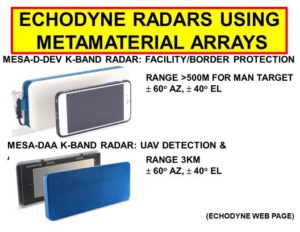
Lecture 1, Nov. 6
FUNDAMENTALS OF Radar: Part 1: Very brief history of radar, major achievements since WWII: PHASED ARRAYS: Principles explained with COBRA DANE used as example. Near and Far Field Defined, Phased Steering, Subarraying, Array Weighting, Monopulse, COBRA DANE slide tour (10 story building).
FUNDAMENTALS OF Radar: Radar equation derived. FREQUENCY TRADEOFFS: Search vs Track, Range and Doppler Ambiguities, Detection in Clutter. Blind Velocity region, range eclipsing, Environmental Factors, Dependence of clutter model on grazing angle and size radar resolution cell discussed, Weibull clutter, Polarization Choice.
Lecture 2, Nov. 13
FUNDAMENTALS of Radar: Part 2: Antenna Pattern Lobing in Elevation due to multipath, Detection of Low Flying Low Cross-Section targets, Ground Multipath Elevation Angle Error Problem and ways to cope with it, e.g., use of an even difference pattern Off-Axis Monopulse, Complex Monopulse,Two Frequency Radar Systems: Marconi L- and S-band S631, Signaal/Thales (Holland),Flycatcher X and Ka System; Tube and Solid State OTH. PROPAGATION: standard, superrefraction, subrefraction, surface-based ducts, evaporation ducts. Determination of radar coverage using new AREPS program. ANTENNA SCANNING SYSTEMS: Fixed Beam System: Wake Measurement Radar; 2-D Radars, 3-D Radars: Stacked Beam: Marconi Martello, Smart-L, SMARTELLO, ARSR-4; 1-D Frequency Scanning: ITT Series 320; 1-D Phased Scanning: TPS-59, GE-592, RAT-31DL; Phased-Frequency Scanners: Raytheon Fire Finder and Plessey AR320.
Lecture 3, Nov. 20
FUNDAMENTALS of Radar: Part 4: ULTRA LOW ANTENNA SIDELOBES (40 dB down or more). MOVING TARGET INDICATOR (MTI): Two-Pulse Canceller, Pulse Doppler Processing; MOVING TARGET DETECTOR (MTD); Optimum Clutter Canceller, Space-Time Adaptive Processing (STAP), Airborne MTI (AMTI), Displaced Phase Center Antenna (DPCA).
Lecture 4, Dec. 4
SIGNAL PROCESSING: Part 1: What is PULSE COMPRESSION? Matched Filters; Chirp Waveform Defined; ANALOG PROCESSING: Surface Acoustic Wave (SAW) Devices: Reflective Array Compressor (RAC), Delay Lines, Bandpass Filters, Oscillators, Resonators; IMCON Devices; Analog Programmable Monolithic SAW Convolver; BBD/CCD. What are they?
Lecture 5, Jan. 8
SIGNAL PROCESSING: Part 2: DIGITAL PROCESSING: Fast Fourier Transform (FFT); Butterfly, Pipeline and In-Place Computation explained in simple terms; Maximum Entropy Method (MEM) Spectral Estimate; State-of-the-art of A/Ds, FPGAs and Memory; Signal Processor Architectures: Pipeline FFT, Distributed, Systolic; Digital Beam Forming (DBF). Future Trends.
Lecture 6, Jan. 22
SYNTHETIC APERTURE RADAR (SAR): Strip and Spotlight SAR explained in simple terms.
TUBES: Basics given of Magnetron, Cross Field Amplifiers, Klystrons, Traveling Wave Tubes, Gyro Tubes.
TREND TOWARD SOLID STATE PHASED-ARRAY TRANSMITTERS: Discrete All Solid State PAVE PAWS and BMEWS radars; advantages over tube radars; MMIC (Monolithic Microwave Integrated Circuitry; integrated circuitry applied to microwaves components): THAAD, SPY-3, IRIDIUM, XBR, JLENS. Solid State ‘Bottle’ Transmitters: ASR -11/DASR, ASR-23SS, ASDE-X. Extreme MMIC.
Breakthroughs and Trends in Radar and Phased-Arrays: Radar on a chip, 258 element phased array on a chip, new revolutionary metamaterial for electronically scanned arrays and target stealthing, Moore’s Law marches forward, quantum anti-stealth radar, you have heard of orthogonal H and V polarization which can double channel data rate, there are an infinite other polarizations called orbital angular momentum (OAM).
Lecture 7, Jan. 29
TRACKING, PREDICTION AND SMOOTHING: αβγ (GHK) Filter; Kalman Filter. All explained in simple physical terms.
Lecture 8, Feb. 5
HOW TO LOOK LIKE A GENIUS IN DETECTION WITHOUT REALLY TRYING: Simple procedure for determining detection. Covered are beam shape, CFAR, mismatch losses.
The Following is Included in Your Registration:
Value
Textbook ………………………………………………….. $159
15 Reprints ……………………………………………$300
Over 800 Vugraphs ………………………………………$120
.

